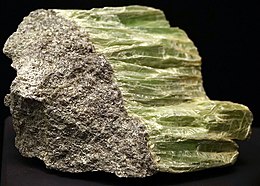
Back صخور السربنتين Arabic Serpentin Azerbaijani Серпенцін Byelorussian Серпентин Bulgarian Subgrup de la serpentina Catalan Skupina serpentinu Czech Serpentingruppe German Σερπεντίνης Greek Serpentina Spanish Serpentiin (mineraal) Estonian
| Serpentine | |
|---|---|
 | |
| General | |
| Category | Phyllosilicates |
| Formula (repeating unit) | X3Si2O5(OH)4, with X = Mg2+, Fe2+, Ni2+, Mn2+, Zn2+ |
| IMA symbol | Srp |
| Crystal system | Monoclinic |
| Identification | |
| Color | Green, yellowish-green, blueish-gray (antigorite) Green, brown, light yellow to white (lizardite) Greyish green to white (chrysotile) |
| Cleavage | Almost perfect |
| Fracture | Brittle |
| Mohs scale hardness | 2.5–6 (original) 3.5–4.0 (antigorite) 2.5 (lizardite) 2.5–3.0 (chrysotile) |
| Luster | Vitreous, silky, greasy, waxy |
| Streak | White,greenish-white |
| Specific gravity | 2.2–2.9 |
| Optical properties | Biaxial (–) |
| Refractive index | 1.538–1.57 (Tolerance:0.004/–0.07) |
| Birefringence | 0.005–0.012 |
| Ultraviolet fluorescence | SWUV: inert to weak blue; LWUV: inert to weak green |
| Diagnostic features | Color, cleavage |
| References | [1][2][3][4] |

Serpentine subgroup (part of the kaolinite-serpentine group in the category of phyllosilicates)[1] are greenish, brownish, or spotted minerals commonly found in serpentinite. They are used as a source of magnesium and asbestos, and as decorative stone.[5] The name comes from the greenish color and smooth or scaly appearance from the Latin serpentinus, meaning "serpent rock".[6]
Serpentine subgroup is a set of common rock-forming hydrous magnesium iron phyllosilicate ((Mg,Fe)
3Si
2O
5(OH)
4) minerals, resulting from the metamorphism of the minerals that are contained in mafic to ultramafic rocks.[7] They may contain minor amounts of other elements including chromium, manganese, cobalt or nickel. In mineralogy and gemology, serpentine may refer to any of the 20 varieties belonging to the serpentine subgroup. Owing to admixture, these varieties are not always easy to individualize, and distinctions are not usually made. There are three important mineral polymorphs of serpentine: antigorite, lizardite and chrysotile.
Serpentine minerals are polymorphous, meaning that they have the same chemical formulae, but the atoms are arranged into different structures, or crystal lattices.[8] Chrysotile, which has a fibrous habit, is one polymorph of serpentine and is one of the more important asbestos minerals. Other polymorphs in the serpentine subgroup may have a platy habit. Antigorite and lizardite are the polymorphs with platy habit.
Many types of serpentine have been used for jewelry and hardstone carving, sometimes under the name "false jade" or "Teton jade".[9][10]
- ^ a b "Serpentine Subgroup". mindat.org. Retrieved 30 April 2021.
- ^ "pyrophyllite | mineral | Britannica". www.britannica.com. Retrieved 2022-11-15.
- ^ "Serpentine | NOVA Mineralogy". Retrieved 2022-11-15.
- ^ "Serpentine: The mineral Serpentine information and pictures". www.minerals.net. Retrieved 2022-11-15.
- ^ Serpentine, American Heritage Dictionary
- ^ Rudler, Frederick William (1911). . In Chisholm, Hugh (ed.). Encyclopædia Britannica. Vol. 24 (11th ed.). Cambridge University Press. pp. 675–677.
- ^ "Serpentine definition in the Dictionary of Geology". Retrieved 9 July 2018.
- ^ "Serpentine: The mineral Serpentine information and pictures". www.minerals.net. Retrieved 4 April 2018.
- ^ National Park Service Archived 2010-09-30 at the Wayback Machine
- ^ Hunter, Sir William Wilson and Burn, Sir Richard, The Imperial Gazetteer of India, Vol. 3, Oxford, England: Clarendon Press, Henry Frowde Publishers (1907), p. 242
© MMXXIII Rich X Search. We shall prevail. All rights reserved. Rich X Search